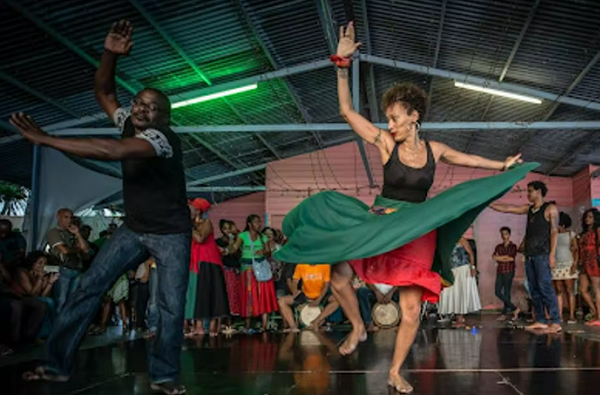Based on her ongoing research, Camee Maddox-Wingfield (University of Maryland) writes about the Martinican bèlè dance traditions for The Conversation. [See more on the author below these excerpts. Many thanks to AICA Caraïbe du Sud for bringing this item to our attention. Also see our previous post Reviving an ancestral dance tradition.]
On May 22 each year, when the eastern Caribbean island of Martinique observes Emancipation Day, drums beat from sunrise until the break of dawn the next day. Participants at open-air, starlit gatherings dance, sing, play drums and feast for ancestors who fought to break the chains of bondage. The uprising that eventually led to the abolition of slavery on the island in 1848 was sparked by the arrest of Romain, an enslaved man who refused to comply with his master’s ban on beating drums.
Today, drums are still a symbol of rebellion and freedom. The traditional dances that span the island each May 22, at performances called “swaré bèlè,” are filled with an electrifying aura of reverence and honor. But the bèlè is not only a genre of ancestral Afro-Caribbean drum-dance practices. Rather, it is “an mannyè viv:” a lifestyle and worldview through which many people find healing and empowerment for themselves and their communities.
[. . .] Centuries of history have given bèlè a complex set of symbols, only understood by those deeply immersed in the practice. Swaré bèlè gatherings typically begin with a few matches of “ladja/danmyé,” a martial art tradition between two combatants in the center of a circle, which warms up the energy of the space as guests are arriving.
The remainder of the event involves an improvised rotation of performers playing and dancing sets from the “bèlè linò” repertoire. These square dances use the quadrille configuration, with four pairs of female and male dancers. After the opening sequences, each pair takes turns dancing in a playful exchange in the center of the circle, then dances toward the drummers to salute them. [. . .]
Repressed, then embraced
Martinique has been under French control since 1635. Even during the post-colonial era, many Black Martinican folk traditions faced repression, as leaders imposed mainland French culture on the population. For example, bèlè practices were often denigrated as “bagay vyé nèg,” “bagay djab” and “bagay ki ja pasé”: primitive, indecent and outdated, in the Martinican Creole language. To many in the church, traditional drumming and dance symbolized heathenism. In a country where the vast majority of people belong to the church, it was difficult for devout Catholics to support bèlè.
Many practitioners see bèlè as a dance of the earth that reinforces human connections with the land, divine spirits and ideals of freedom. Touted as a fertility ritual for both humans and the land, the dance reflects sensuality between partners. Other symbolism suggests sacred connections with the soil, vegetation and water on which Martinicans’ enslaved ancestors labored and survived. Many dance movements represent agricultural labor.
During the 1980s, student activists and youth groups led initiatives to revive traditions that had nearly dissolved as a result of French pressure to assimilate. Today an ever-growing community has embraced bèlè as they challenge the legacy of colonialism and racism in Martinique. [. . .]
[Camee Maddox-Wingfield is Assistant Professor of Sociology, Anthropology, and Public Health; University of Maryland, Baltimore County. For this research, Camee Maddox-Wingfield received funding from the Institute of International Education (Mellon Foundation Graduate Fellowship for International Study), a grant from the Ruth Landes Memorial Research Fund (a Program of the Reed Foundation), and UMBC’s Center for Social Science Scholarship Summer Faculty Fellowship.]
For more photos and full article, see https://theconversation.com/institutions/university-of-maryland-baltimore-county-1667. Photo above: Dancers Clara Desportes and Simon Lavenaire in Fort de France during Emancipation Day celebrations in 2016. Courtesy of Gilles Ticaze Cazenave.
Also see our previous post https://repeatingislands.com/2021/05/06/how-black-caribbean-communities-are-reviving-an-ancestral-dance-tradition/
For more on the author, see https://theconversation.com/profiles/camee-maddox-wingfield-1324479


2 thoughts on “The Martinican bèlè dance – a celebration of land, spirit and liberation”